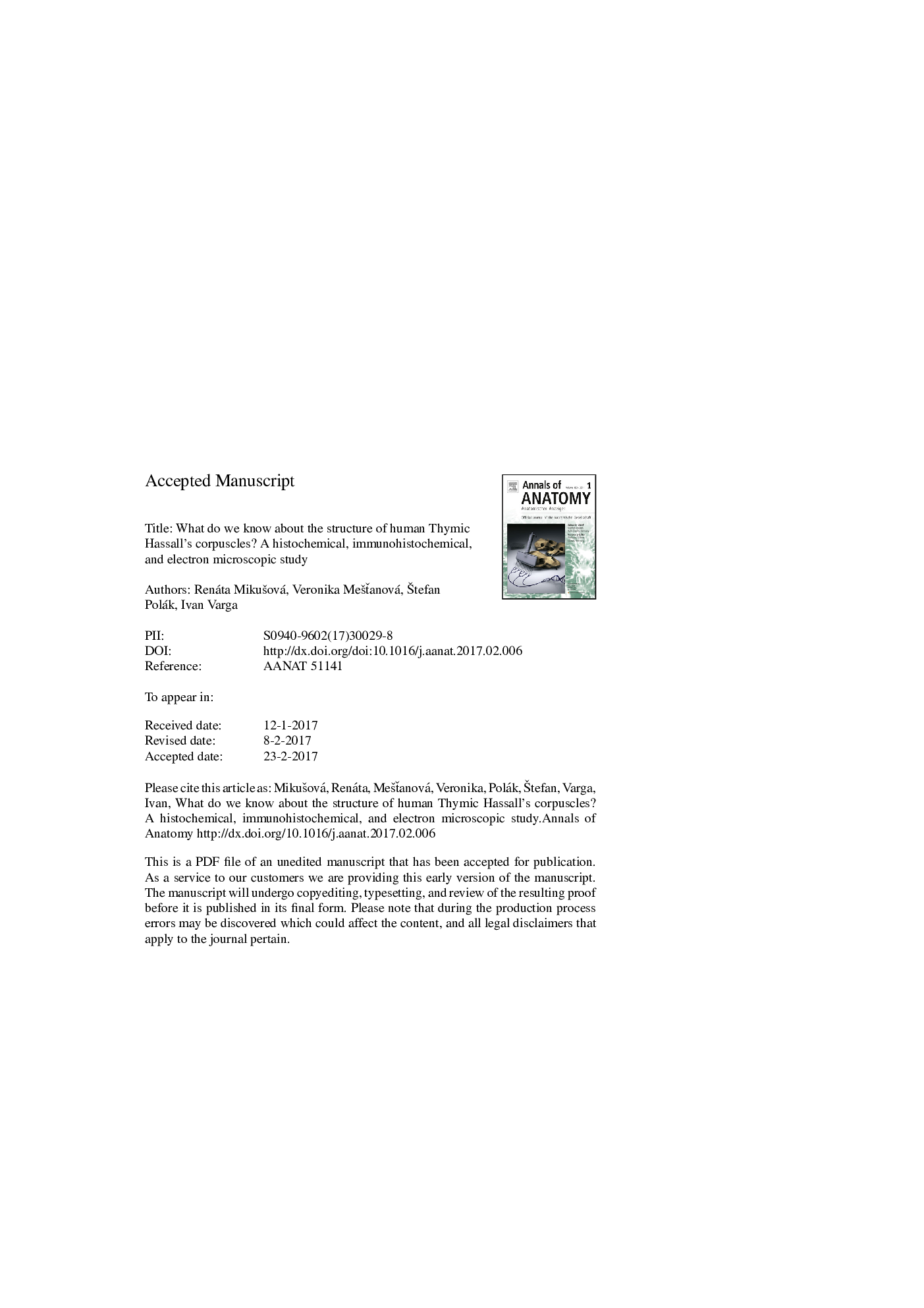| کد مقاله | کد نشریه | سال انتشار | مقاله انگلیسی | نسخه تمام متن |
|---|---|---|---|---|
| 8460489 | 1548985 | 2017 | 25 صفحه PDF | دانلود رایگان |
عنوان انگلیسی مقاله ISI
What do we know about the structure of human thymic Hassall's corpuscles? A histochemical, immunohistochemical, and electron microscopic study
ترجمه فارسی عنوان
ما در مورد ساختار قارچهای حسیل بدن انسان چه می دانیم؟ یک مطالعه میکروسکوپ الکترونی، هیستوشیمی، ایمونوهیستوشیمی و الکترون
دانلود مقاله + سفارش ترجمه
دانلود مقاله ISI انگلیسی
رایگان برای ایرانیان
کلمات کلیدی
HMWBcl2Periodic Acid Schiff - اسید فسفریکHuman thymus - تامیوس انسانیepithelial cells - سلول بافت پوششی یا اپیتلیومDendritic cells - سلول های دندریتیکNK cells - سلولهای NKEndothelial cells - سلولهای اندوتلیالNatural killer cells - سلولهای کشنده طبیعیLymphocytes - لنفوسیت هاB-cell lymphoma 2 - لنفوم سلول B 2Macrophages - ماکروفاژها،درشت خوارهاMHC - مجموعه سازگاری بافتی اصلیmajor histocompatibility complex - مجموعه سازگاری بافتی اصلیPAS - نهhigh molecular weight - وزن مولکولی بالا
موضوعات مرتبط
علوم زیستی و بیوفناوری
بیوشیمی، ژنتیک و زیست شناسی مولکولی
بیولوژی سلول
چکیده انگلیسی
Hassall's corpuscles are the most prominent structures in the human thymus. However, relatively few analyses have been performed to determine their function and cellular origins during development. In this study, we evaluated the cellular microenvironment of human thymic Hassall's corpuscles using histochemistry, immunohistochemistry, and transmission electron microscopy. We examined 95 human thymic tissue samples, which were perioperatively obtained from children undergoing cardiac surgery. To characterize the complex cellular microenvironment of human thymic corpuscles, we used a panel of 14 different antibodies to identify discrete cell types. We also utilized various histochemical methods (PAS reaction, alcian blue staining, alkaline phosphatase and acid phosphatase activity staining, von Kossa staining of calcified particles) and transmission electron microscopy to visualize these structures. Considerable variation in the sizes, shapes, and numbers of Hassall's corpuscles was observed, even amongst children of the same age. Inside the largest Hassall's corpuscles, cystic dilatation with an accumulation of cellular debris was found. These morphological observations might be associated with disruptions in the formation, migration, or differentiation of cardiac neural crest cells, which are essential for heart and thymus development. Immunohistochemical staining and electron microscopy revealed that Hassall's corpuscles resemble other types of stratified squamous epithelia. Most Hassall's corpuscles are heterocellular, consisting of thymic epithelial cells, macrophages, interdigitating dendritic cells, myoid cells, and, occasionally, mast cells and lymphocytes. To explore the potential functions of Hassall's corpuscles, we found that the concentrations of B-lymphocytes and BCL2-positive lymphocytes suggested a role in regulation of lymphopoiesis. We also found that these structures do not originate from the perivascular epithelium as previously proposed, nor could we identify blood or lymph endothelial cells in close proximity. This leaves the origins of Hassall's corpuscles an open question.
ناشر
Database: Elsevier - ScienceDirect (ساینس دایرکت)
Journal: Annals of Anatomy - Anatomischer Anzeiger - Volume 211, May 2017, Pages 140-148
Journal: Annals of Anatomy - Anatomischer Anzeiger - Volume 211, May 2017, Pages 140-148
نویسندگان
Renáta MikuÅ¡ová, Veronika MeÅ¡Å¥anová, Å tefan Polák, Ivan Varga,
